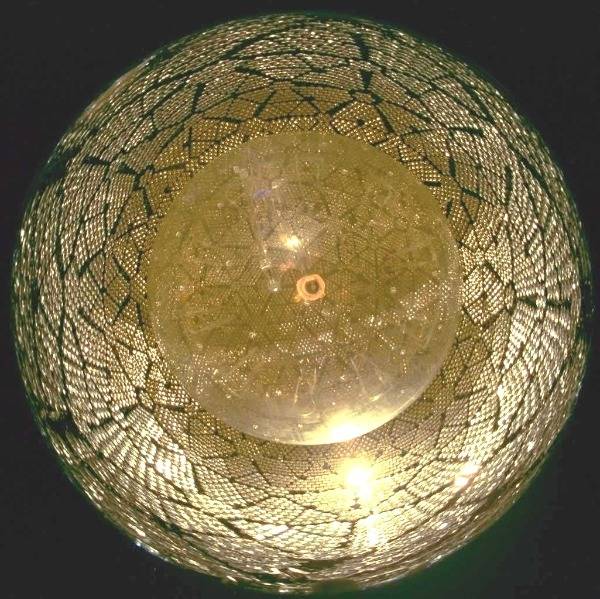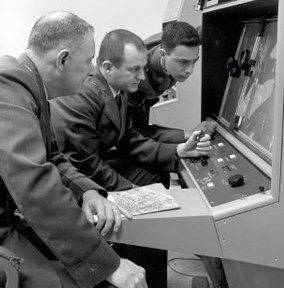This article is a preview from the Winter 2017 edition of New Humanist.
Chemistry – Mark Lorch
Life is really just a mass of interlocking chemical processes, controlled by nature’s nano-machines and micro-structures, most frequently comprised of proteins and sometimes nucleic acids. Visualising these molecules is key to understanding them and so life itself. However, most are far too small to see with a light microscope.
Electron microscopes (EM) offer much better resolution, but the power of an electron beam and the high vacuum that the sample must be kept at destroy frail biological materials. To get around this, biological samples are often coated with a thin layer of gold. This preserves their shape even in the harsh conditions that EMs require. This technique works to produce images revealing the scales on a butterfly wing or the elements of an ant’s compound eye. But proteins are tens of thousands of times smaller still, so even the thinnest layer of gold obliterates detail.
This year’s Nobel Prize for chemistry was awarded to Jacques Dubochet, Joachim Frank and Richard Henderson for developing ways to get around this problem, leading to stunningly useful and beautiful images of the chemical workhorses of biology.
To preserve the samples, Henderson turned away from the coating technique and embraced the cold. His team cooled a protein to -120oC, which limited the damage done by the electrons. In this way, in 1990, they were able to obtain the first cryro-EM image of a protein. But the vacuum caused rapid evaporation of any water. And since the chemistry of life happens in water, retaining it is vitally important to maintain the natural shape of the biological molecule. Dubochet created a way to very rapidly cool samples and keep the water intact.
One last problem remained. Individual cryo-EM images are in blurry 2D. Frank came up with an image processing method that averages thousands of images and merges them to reveal the 3D shape of proteins.
Take a few moments now to search for cryo-EM images. You won’t be disappointed at the natural beauty of nano-scale nature.
Mark Lorch lectures in chemistry at Hull University
Biology – Lydia Leon
Persistent vegetative states are rare, tragic disorders where patients are wakeful but unconscious. If the condition lasts more than a year, patients are highly unlikely to recover consciousness, and in the UK “passive euthanasia”, in which nutritional support is withdrawn, may be recommended. Little is available to clinicians, and families, to predict – or alter – the progression of the disorders.
However, a report in the journal Current Biology has the potential to change that. The study focused on a 34-year-old man who fell into a persistent vegetative state after a car accident 15 years previously. A group of neuroscientists from the Institute of Cognitive Sciences in Lyon carried out pioneering therapy in which the vagus nerve, a key component of the central nervous system involved in such essential functions as alertness and walking, was stimulated for a number of months. The patient was chosen as the first recipient of the treatment because the severity and length of his unconscious state meant that any improvements were unlikely to be chance events.
Following a 20-minute operation, in which a device was fitted in the patient’s chest, his vagus nerve was stimulated. His behavioural and cognitive capacities before and after the treatment were compared. Significant improvements were noted after just a month. The man turned his head on request, followed objects with his eyes, and stayed awake while his therapist read a book. His score on the Coma Recovery Scale improved significantly, indicating a transition from a “vegetative” to “minimally conscious” state.
These observations are clearly preliminary, given that they relate to a single patient. However, they indicate potentially revolutionary advances in the capacity to improve the outcome of patients trapped in states of reduced consciousness. The group is now planning a larger collaborative study with more patients. The hope is that the treatment could be applied more widely to improve patients’ presence in the world around them, as well as our understanding of the mystery of consciousness itself.
Lydia Leon is a research associate in women’s health at Kings College London and University College London
Physics – Ceri Brenner
Infrared cameras are great fun. They reveal that our surroundings are radiating infrared light – the glow associated with heat. Our eyes only allow us to see the world via visible light bouncing off stuff but with these special cameras we’re able to see another level of information. They reveal things that are otherwise invisible to us. Similarly, UV and x-ray cameras, or radio antennas and WiFi chips, also detect and read out invisible light waves that pass by us all the time. And now we can add gravitational waves to that list. Observing these waves tells us that the universe ripples after a gigantic violent cosmic event. It’s a fantastic new set of goggles that will revolutionise astronomy. Three leaders of the LIGO (Laser Interferometer Gravitational-Wave Observatory) project – Rainer Weiss, Barry Barish and Kip Thorne – were awarded this year’s Nobel Prize in Physics “for decisive contributions to the LIGO detector and the observation of gravitational waves”.
Within a few weeks of the Nobel Prize announcement another gravitational waves observation hit the news. A paper published in Physics Review Letters in October details the first direct observation via gravitational waves of the collision of two neutron stars. The US-based LIGO detector together with the Italy-based VIRGO detector acted as the sirens that told telescopes to be on the look-out. This is top-end drama in physics. LIGO and VIRGO worked together to pinpoint the direction the waves were coming from. This was then passed on with haste so that telescopes around the world could be pointed that way: lo and behold, they managed to catch the light coming from the aftermath of the collision. For the first time, astronomers have information on both the gravitational and light energy emitted during an event so violent that it vibrates space-time. Specific light signatures were spotted, which confirm the theory that precious metals, such as gold and platinum are formed under the extreme conditions of a kilonova explosion. Yes, your ring came from a neutron star collision. What a revelation!
Ceri Brenner is a physicist who works for the Science and Technology Facilities Council

